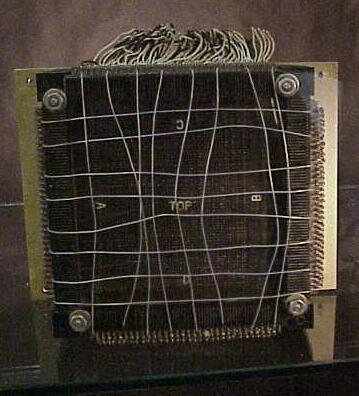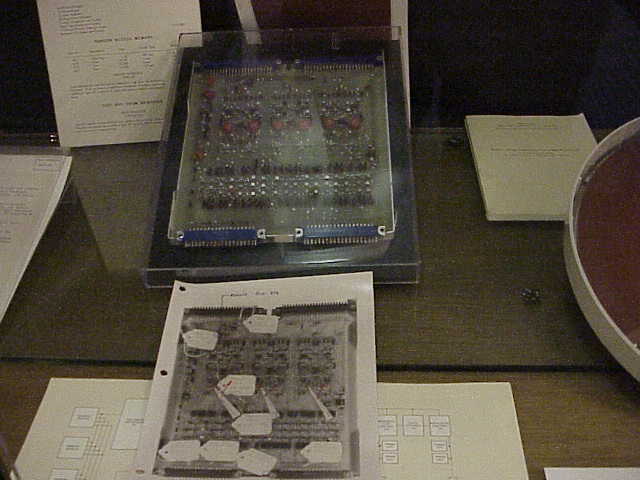Early Digital Equipment Computing
 |
 |
 |
 |
The `Programmed Data Processor 1' was the first of series of
14 (no PDP-13) computer systems, using similar components, but differing greatly
in capability. Intial modules used discrete transistors, later `flip-chip modules' used small-scale
integration, having up to a dozen transistors in a package.
The PDP-1 (1960) was the first DEC machine, with an 18-bit word, and
was used to develop time-sharing operating systems.
The PDP-2 was a PDP-1 withs an alternate memory board.
The PDP-1 was
followed by the PDP-6 (1963), the PDP-10KA (1968), -KI, and -KL,
having 36-bit word sizes.
These were larger systems, delivered with time-sharing capabilty and ever
larger memories. Eventually these systems were sold as DECSYSTEM-10s and
the -KL20 as DECSYSTEM-20s, sold up to 1983.
DECSYSTEM-20s, with the BBN TENEX timesharing system, became the
dominant machine for the ARPAnet.
At Stanford's SAIL
a PDP-10 copy built, called
FOONLY,
enabling more modern time-sharing concepts, leading to the TOPS-20 software
for the DECSYSTEM-20s.
David Poole formed a FOONLY company around 1974, when ARPA's funding
stopped.
XEROX PARC also built an internal copy of A DEC-10 as its MAXC computer.
Only 1 PDP-3 (1961) was a special order, it was a 36-bit
business-oriented computer.
The PDP-4 (1962), PDP-7, PDP-9, and PDP-15 (1970) were a large 18-bit
computers oriented towards business customers, but actually mainly
used in engineering settings.
The PDP-7 was the first machine used for UNIX.
The PDP-5 (1963-1967), PDP-8 (1965-1968), the slow and cheaper PDP-8S
(1966-1970), PDP-8I and PDP-8L (1968-1971), and PDP-12 (1969-1973)
were 12-bit mini-computers of increasing capability, as 1K, 4K, and 12K
memory.
[Information from
Laboratory Computer (LINC) (1960?), assembled from the same modules, with
real-time access ports. Output could be displayed on Tektronix 560 Memory
Oscilloscope (to be displayed).
There were also combinations, namely the LINC-8 (1966-1969) and LINC-12.
The PDP-8 had a military, hardened version, the Army Navy Ground-based Data
Processing Komputer 6 (AN/GYK-6).
The PDP-11 and PDP-11LSI were very successful successors 16-bit
mini-computers, and led to
the VAX series which covered a wider range of capabilities. For laboratory
needs a LAB-11 was produced.
See also
Brian Stuart's
linage on William Bader's VAX web site.
Gordon Bell has been involved with building computer systems since 1959, since graduating from M.I.T. In 1960 he joined Digital Equipment Corporation and was responsible for the first minis and timeshared computers, including the VAX. In 1987 he established the computing directorate at the National Science Foundation and lead the cross-agency group and plan for the first Internet. He is a founder of The Computer History Museum-Mountain View, CA, a Fellow of various professional organizations and a Member of the National Academy of Engineering. Awards include the 1991 National Medal of Technology, an honorary doctorate in engineering from Worcester Polytechnic Institute, and the 2001 Eta Kappa Nu Karapetoff Award for lifetime accomplishments. He has written several books about computer systems, and High Tech Ventures(1991) based on his involvement with about 80 startup companies. Since joining Microsoft's Bay Area Research Center as a Senior Researcher in 1995, his work includes scalable computing, telepresence, and cyberizing everything in the MyLifeBits project [Software Forum, 2004].
A PDP-6, was the mainstay of Stanford's
AI
Lab. Faculty, students, and engineers modified the hardware and
software frequently, developing concepts that affected the development
of all future computers and their software.
Developments in timesharing are described in the
current display.
 |
Gordon Bell is top left. Does someone recognize the others?
 |
Core Memory This Core memory is from a vintage 1960's computer. It has 12 planes, each 33 x 33. This gives it 13,068 bits or approx. 1630 bytes of memory. Invented in 1952, magnetic core memory was the primary memory for all computers until replaced by solid state, integrated circuits in the 1970's. Magnetic cores were always "strung" by hand with the cores getting smaller to be ever more dense. A successful core-stringing machine was never made. From the collections of the Computer Museum History Center. Text transcribed by Gio Wiederhold. |
It is likely that one bit per line was used for checking or as a spare,
and that the computer using this memory stack had 32 x 32 = 1024 words
of 12 bits each.
For a brief description of the technology look at the
page on Core memory.
 |
 |
 |
 |
 |
 |
 |
 |